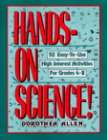Objective
The first thing most people notice about weather is the temperature. This activity will show you how to make a thermometer.
Materials
- Commercial thermometer
- Clear, thin, stiff plastic tubing at least 30 cm (12 in.) long (balloon sticks are just right)
- 1-hole rubber stopper to fit bottle
- Warm water
- Red food coloring
- Flask or small-mouthed glass bottle (cough medicine, juice bottle, etc.)
- 3"×5" index card (or larger card)
Procedure
- The first thing most people notice about weather is the temperature. Thermometers, which measure temperature, are easy to make. You might have learned from earlier science activities that liquids expand when they are heated and contract when they are cooled.
- Fill the bottle with warm water. Add several drops of red food coloring.
3. Insert the plastic tube through the stopper and fit the stopper tightly in the bottle. Water should be forced into the tube as you press the stopper into place. - Adjust the water level so the water will rise nearly halfway up the tube.
- Make a slit near the bottom of the index card and another near the top and slide it behind the tube.
- Wait about an hour for the water to reach room temperature.
- Consult the commercial thermometer and mark the present temperature with a line on the index card.
- Each morning and afternoon, compare the commercial thermometer with the one you have made. Make new lines to show changes.
For Problem Solvers
Check the temperature on your thermometer each morning, noon,and night for at least one month. Try to do it at about the same time each day. For the first few days, compare the temperatures shown on your thermometer with those of a commercial thermometer to be sure you have calibrated your thermometer accurately. You will gain confidence in your thermometer as you use it.
Make a graph of day-by-day temperatures, using your homemade thermometer. Be sure to check the temperature at the same time each day. Estimate the temperature each time before you read the thermometer.
What are the temperature limits of your thermometer? At what temperature does the liquid rise to the top of the tube, if at all, and at what temperature does it drop out of sight at the bottom? Design a way to find out, and compare with others who are doing this activity.
Your thermometer works on the principle of expansion and contraction of liquids with temperature change. Do some research and find out what other ways are used to measure temperature. Learn what you can about instruments people have used for this purpose through the years.
Teacher Information
Ordinary methyl alcohol (or rubbing alcohol) may be substituted for water if the thermometer is to be left outside in below-freezing temperatures.
CAUTION: Methyl alcohol is poisonous if taken internally.
The water expands because the molecules move more rapidly and push against one another as they are heated. As water cools, the molecules move more slowly and require less space, so the water contracts.
Balloon sticks are perfect as thermometer tubes. They are stiff, they fit the one-hole rubber stopper, and they are readily available at party supply outlets.
Excerpt from Hands-On Science.
Excerpted from




